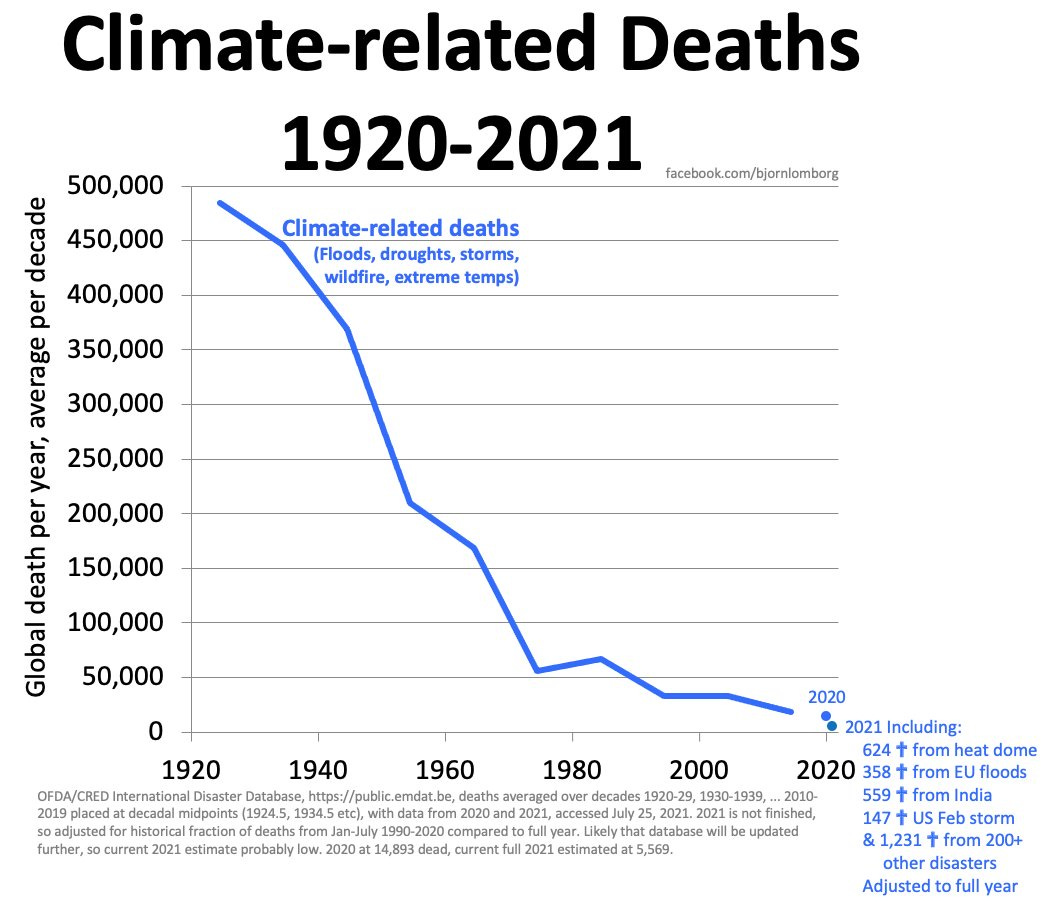The Collapse of Climate-Related Deaths
Climate continues to be a challenge but climate-related deaths have fallen over 99 percent since 1920.

The Gulf coast has been devastated by Hurricane Ida. CNBC reports “Ida made landfall in Louisiana on Sunday as a Category 4 storm with winds of 150 miles per hour, one of the strongest storms to hit the region since Hurricane Katrina. Rainfall could total 24 inches across portions of southeast Louisiana into far southern Mississippi.” The property damage will no doubt be significant. Nineteen deaths have been confirmed and the death toll is likely to increase. Hurricane Katrina in 2005 caused 1,833 deaths.
Compare Ida to the Great Galveston Hurricane that made landfall on September 9th 1900. The storm caused an estimated 8,000 to 12,000 deaths. In 1915 a storm similar in strength struck Galveston. The 1915 storm resulted in only 53 deaths. How did Galveston go from so many deaths to so few, reducing hurricane fatalities by 99 percent in 15 years? Human beings have proved again and again how supremely adaptable we can be. In 1902 the residents of Galveston voted to fund building a seawall. Upon completion, the 17 foot seawall stretched for more than 10 miles. They also dredged sand from the shipping channel and raised many buildings, some by as much as 17 feet.
The deadliest Atlantic hurricane in recorded history was the Great Hurricane of 1780, which resulted in 22,000–27,501 fatalities. In recent years, the deadliest hurricane was Hurricane Mitch of 1998, with at least 11,374 deaths attributed to it.1
Bjorn Lomborg has reported that climate related deaths averaged 485,000 a year in the 1920s. In the last full decade, 2010-2019, the average was 18,362 dead per year. In 2020 it had dropped to 14,893. Based on what has been reported so far in 2021, the estimate is 5,569. Adjusted for population, we went from 255.3 deaths per million in 1920 to 1.9 per million in 2020, a 99.25 percent decrease.
On a population-adjusted basis, for every climate-related death in 2020, we had 133.6 deaths in 1920. If the 2021 trend continues, the rate will be one death in 2021 for 361 deaths in 1920.
Adjusted for population size, for every 133.6 lives lost due to climate in 1920, only one was lost in 2020. We have 132.6 people alive today that would have been lost in 1920. Life abundance has increased by 13,260 percent. We are becoming around 5 percent safer every year from these kinds of deaths. Lomborg notes:
This is clearly the opposite of what you hear, but that is because we're often just being told of one disaster after another – telling us how *many* events are happening. The number of reported events are increasing, but that is mainly due to better reporting, lower thresholds, and better accessibility (the CNN effect).
Instead of generating more advertising profits for media organizations, look at the number of dead per year as reported by the most respected global database, the International Disaster Database (https://public.emdat.be/). You can also read more from Lomborg’s peer-reviewed article here.
Will there continue to be dangerous climate and more deaths? Yes, but we must put these catastrophes into context with facts. Our ability to adapt and thrive under negative climate conditions over the last 100 years has been astonishing. Let facts, not advertising dollars inform your thinking.
Excerpt from our forthcoming book, Age of Superabundance
Gale Pooley is a Senior Fellow at the Discovery Institute and a board member at Human Progress
https://en.wikipedia.org/wiki/List_of_deadliest_Atlantic_hurricanes




